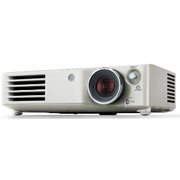
|
contents | hardware | |||||||
| Panasonic Debuts Its PT-AX200U LCD Home Theater Projector  Panasonic Projector Systems Company, Unit of Panasonic Corporation of North America, announces the unveiling of its new PT-AX200U LCD (1280 x 720 pixels) home theater projector. The PT-AX200U projector produces bright, eye-catching images, buoyed by its 220-W UHM lamp and optical unit that combine to generate 2,000-lumen brightness. It also incorporates Panasonic's improved Light Harmonizer 2 image technology, which measures ambient light and adjusts the image brightness by controlling not only the gamma curve, but also the iris setting, lamp power, and picture sharpness to maintain bright, crisp and vivid pictures under any lighting condition. Panasonic Projector Systems Company, Unit of Panasonic Corporation of North America, announces the unveiling of its new PT-AX200U LCD (1280 x 720 pixels) home theater projector. The PT-AX200U projector produces bright, eye-catching images, buoyed by its 220-W UHM lamp and optical unit that combine to generate 2,000-lumen brightness. It also incorporates Panasonic's improved Light Harmonizer 2 image technology, which measures ambient light and adjusts the image brightness by controlling not only the gamma curve, but also the iris setting, lamp power, and picture sharpness to maintain bright, crisp and vivid pictures under any lighting condition.The PT-AX200U ships with a new gaming mode so consumers can enjoy playing their favorite video games. According to the Entertainment Software Association, game software sales reached approximately 240 million units during 2006 and Panasonic is poised to begin capturing this market. Compared with Panasonic's prior model, the new projector's gaming mode improves signal processing for 1/3 response time, using the controller buttons. Gamers can also program and save up to eight settings for games or movies, making it easy to view the content as they wish. In addition, picture quality characteristics have been specifically tuned to reveal more image details that were previously not as visible in very dark or over-saturated areas that are prevalent in many games. The PT-AX200U projector reproduces Hollywood movies, independent films and other entertainment with exceptional color accuracy and sharpness. Its new Advanced Dynamic Sharpness Control intelligently determines image areas that need to be sharpened at varying degrees to deliver clear and natural-looking pictures. The refined Dynamic Iris adjusts the unit's optical iris, the UHM lamp and gamma curve 60 times per second at stunning smoothness to produce beautiful images with a 6,000:1 contrast ratio. The PT-AX200U's Pure Color Filter uses optical adjustment to achieve accurate color reproduction, going a step further than conventional projectors that reproduce colors by adjusting the white balance. The color filter achieves a higher purity level of the three primary colors – red, green and blue – displays deeper, purer blacks, and significantly expands the color gamut. In addition, the new Smooth Screen technology uses crystal double refraction to arrange pixels on a screen with no gaps in between them – producing vivid, smooth images found in commercial movie theaters. The technology also enhances images' three dimensional effect for a completely immersive viewer experience. The new home theater projector's Cinema Color Management feature allows the users to control color correction of up to approximately 1,070,000,000 colors to create images to their liking. The users can now store up to eight adjustment settings into the memory with custom names. Thanks to the PT-AX200's 2x optical zoom lens and lens shift function, the new projector now offers consumers more places to view their favorite home entertainment. Viewers can easily set up and install the projector on a coffee table, suspend it from the ceiling, or set it on a bookshelf. The projector can cast a 100-inch image at a range of approximately three to six meters from the screen, and its pearl-white color and sleek cabinet design fit well in almost any room d?cor. The PT-AX200 also comes equipped with two HDMI inputs, eliminating the need for an HDMI switcher. Finally, the new model's remote control has powerful settings for different types of video such as television sports, home movies or commercial films. Building upon the PT-AX200U's feature set, Panasonic also announces its next advanced, full high-definition, 1080p home theater projector – the PT-AE2000U – designed for savvy home theater enthusiasts and audio-video professionals. The Panasonic PT-AX200U LCD home theater projector will be available in October at Panasonic authorized presentation systems dealers. write your comments about the article :: © 2007 Computing News :: home page |